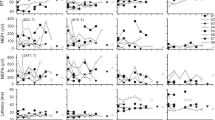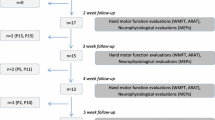Abstract
Background
Altered corticospinal excitability in Parkinson’s disease (PD) is related to many of the motor signs.
Objective
We examined whether the recruitment properties of the corticospinal pathway to hand muscles are changed after 8 weeks of specialized upper limbs exercise in PD.
Methods
Seven PD subjects were enrolled. Upper limb exercise was achieved by using a specially designed device. The input–output (I–O) curves were obtained by transcranial magnetic stimulation (TMS). The conduction of peripheral axons and H reflex was also recorded. UPDRS scale, part-III motor examination was used to assess the motor symptom. Clinical and neurophysiological data were obtained before and after 2-month exercise training.
Results
After 2-month exercise training, the UPDRS score was significantly improved. Threshold, slope, and V50 (i.e., the stimulus intensity required to obtain a response 50% of the maximum) of the I–O curve were unchanged, whereas the plateau value was significantly higher.
Conclusions
Exercise training affects the larger motoneurons, that is those activated at higher TMS stimulation intensity. These motoneurones are related to the large, type II motor units. Clinical improvement after exercise may depend upon restoration of the recruitment of the large motor unit, i.e., those necessary to perform rapid and strong movements, known to be deficient in PD.


Similar content being viewed by others
References
Albin RL, Young AB, Penney JB (1989) The functional anatomy of basal ganglia disorders. Trends Neurosci 12:366–375
DeLong MR (1990) Primate models of movement disorders of basal ganglia origin. Trends in Neurosciences 13:281–285
Alexander GE, Crutcher MD (1990) Functional architecture of basal ganglia circuits: neural substrates of parallel processing. Trends Neurosci 13:266–271
Wichmann T, DeLong MR (2003) Functional neuroanatomy of the basal ganglia in Parkinson's disease. Adv Neurol 91:9–18
Parr-Brownlie LC, Hyland BI (2005) Bradykinesia induced by dopamine D2 receptor blockade is associated with reduced motor cortex activity in the rat. J Neurosci 25:5700–5709
Pasquereau B, Turner RS (2011) Primary motor cortex of the parkinsonian monkey: differential effects on the spontaneous activity of pyramidal tract-type neurons. Cereb Cortex 21:1362–1378
Cantello R, Tarletti R, Civardi C (2002) Transcranial magnetic stimulation and Parkinson’s disease. Brain Res Rev 38:309–327
Leon-Sarmiento FE, Rizzo-Sierra CV, Bayona EA, Bayona-Prieto J, Doty RL, Bara-Jimenez W (2013) Novel mechanisms underlying inhibitory and facilitatory transcranial magnetic stimulation abnormalities in Parkinson's disease. Arch Med Res 44:221–228
Tomlinson CL, Patel S, Meek C, Herd CP, Clarke CE, Stowe R, Shah L, Sackley C, Deane KH, Wheatley K, Ives N (2012) Physiotherapy intervention in Parkinson's disease: systematic review and meta-analysis. BMJ 345:e5004
Messa LV, Ginanneschi F, Momi D, Monti L, Battisti C, Cioncoloni D, Pucci B, Santarnecchi E, Rossi A (2019) Functional and brain activation changes following specialized upper-limb exercise in Parkinson’s disease. Front Hum Neurosci 13:350
Ziemann U, Tergau F, Wassermann EM, Wischer S, Hildebrandt J, Paulus W (1998) Demonstration of facilitatory I wave interaction in the human motor cortex by paired transcranial magnetic stimulation. J Physiol 511:181–190
Cavaleri R, Schabrun SM, Chipchase LS (2017) The number of stimuli required to reliably assess corticomotor excitability and primary motor cortical representations using transcranial magnetic stimulation (TMS): a systematic review and meta-analysis. Syst Rev 6:48
Ginanneschi F, Mondelli M, Dominici F, Rossi A (2006) Changes in motor axon recruitment in the median nerve in mild carpal tunnel syndrome. Clin Neurophysiol 117:2467–2472
Messa LV, Biffi A, Fernando F, Ginanneschi F, Rossi A (2016) Tailored exercise with an innovative mechanical device: effects on cervical-dorsal rachis. J Funct Morphol Kinesiol 1:183–189
Alberts JL, Phillips M, Lowe MJ, Frankemolle A, Thota A, Beall EB, Feldman M, Ahmed A, Ridgel AL (2016) Cortical and motor responses to acute forced exercise in Parkinsons disease. Parkinsonism Relat Disord 24:56–62
Devanne H, Lavoie BA, Capaday C (1997) Input-output properties and gain changes in the human corticospinal pathway. Exp Brain Res 114:329–338
Capaday C (1997) Neurophysiological methods for studies of the motor system in freely moving human subjects. J Neurosci Methods 74:201–218
Carroll TJ, Riek S, Carson RG (2001) Reliability of the input-output properties of the cortico-spinal pathway obtained from transcranial magnetic and electrical stimulation. J Neurosci Methods 112:193–202
Rothwell JC, Thompson PD, Day BL, Boyd S, Marsden CD (1991) Stimulation of the human motor cortex through the scalp. Exp Physiol 76:159–200
Kaelin-Lang A, Luft AR, Sawaki L, Burstein AH, Sohn YH, Cohen LG (2002) Modulation of human corticomotor excitability by somatosensory input. J Physiol 540:623–633
Burciu RG, Vaillancourt DE (2018) Imaging of motor cortex physiology in Parkinson’s disease. MovDisord 33:1688–1699
Berardelli A, Rothwell JC, Thompson PD, Hallett M (2001) Pathophysiology of bradykinesia in Parkinson’s disease. Brain 124:2131–2146
Wu T, Wang L, Hallett M, Chen Y, Li K, Chan P (2011) Effective connectivity of brain networks during self-initiated movement in Parkinson’s disease. Neuroimage 55:204–215
Bologna M, Paparella G, Fasano A, Hallett M, Berardelli A (2020) Evolving concepts on bradykinesia. Brain 143:727–750
Bologna M, Guerra A, Paparella G, Giordo L, Alunni Fegatelli D, Vestri AR, Rothwell JC, Berardelli A (2018) Neurophysiological correlates of bradykinesia in Parkinson’s disease. Brain 141:2432–2444
Kojovic M, Bologna M, Kassavetis P, Murase N, Palomar FJ, Berardelli A, Rothwell JC, Edwards MJ, Bhatia KP (2010) Functional reorganization of sensorimotor cortex in early Parkinson disease. Neurology 78:1441–1448
Kimiskidis VK, Papayiannopoulos S, Sotirakoglou K, Karakasis H, Katsarou Z, Kazis DA, Papaliagkas V, Gatzonis S, Papadimitriou A, Hadjigeorgiou G, Bostanjopoulou S (2018) The cortical excitability profile of patients with the G209A SNCA mutation versus patients with sporadic Parkinson’s disease: a transcranial magnetic stimulation study. Neurophysiol Clin 48:203–206
Kačar A, Filipović SR, Kresojević N, Milanović SD, Ljubisavljević L, Kostić SV, Rothwell JC (2013) History ofexposure to dopaminergic medication does not affect motor cortex plasticity and excitability in Parkinson’s disease. Clin Neurophysiol 124:697–707
Wickens J, Hyland B, Anson G (1994) Cortical cell assemblies: a possible mechanism for motor programs. J Mot Behav 26:66–82
Poliakov AV, Miles TS (1992) Quantitative analysis of reflex responses in the averaged surface electromyogram. J Neurosci Methods 43:195–200
Magistris MR, Rosler KM, Truffert A, Myers JP (1998) Transcranial stimulation excites virtually all motor neurons supplying the target muscle. A demonstration and a method improving the study of motor evoked potentials. Brain 121:437–450
Paparella G, Rocchi L, Bologna M, Berardelli A, Rothwell J (2020) Differential effects of motor skill acquisition on the primary motor and sensory cortices in healthy humans. J Physiol 598:4031–4045
Berghuis KMM, Semmler JG, Opie GM, Post AK, Hortobágyi T (2017) Age-related changes in corticospinal excitability and intracortical inhibition after upper extremity motor learning: a systematic review and meta-analysis. Neurobiol Aging 55:61–71
Edström L (1970) Selective changes in the sizes of red and white muscle fibres in upper motor lesions and Parkinsonism. J Neurol Sci 11:537–550
Rossi B, Siciliano G, Carboncini MC, Manca ML, Massetani R, Viacava P, Muratorio A (1996) Muscle modifications in Parkinson'sdisease: myoelectric manifestations. Electroencephalogr Clin Neurophysiol 101:211–218
Mu L, Sobotka S, Chen J, Su H, Sanders I, Adler CH, Shill HA, Caviness JN, Samanta JE, Beach TG (2012) Arizona Parkinson’s Disease Consortium. Altered pharyngeal muscles in Parkinson disease. J Neuropathol Exp Neurol 71:520–530
Kelly NA, Hammond KG, Bickel CS, Windham ST, Tuggle SC, Bamman MM (1985) Effects of aging and Parkinson’s disease on motor unit remodeling: influence of resistance exercise training. J Appl Physiol 124:888–898
Glendinning DS, Enoka RM (1994) Motor unit behavior in Parkinson’s disease. Phys Ther 74:61–70
Rose MH, Løkkegaard A, Sonne-Holm S, Jensen BR (2013) Effects of training and weight support on muscle activation in Parkinson’s disease. J Electromyogr Kinesiol 23:1499–1504
Hallett M, Khoshbin S (1980) A physiological mechanism of bradykinesia. Brain 103:301–314
Calancie B, Nordin M, Wallin U, Hagbarth KE (1987) Motor-unit responses in human wrist flexor and extensor muscles to transcranial cortical stimuli. J Neurophysiol 58:1168–1185
Colebatch JG, Rothwell JC, Day BL, Thompson PD, Marsden CD (1990) Cortical outflow to proximal arm muscles in man. Brain 113:1843–1856
Boniface SJ, Mills KR, Schubert M (1991) Responses of single spinal motoneurons to magnetic brain stimulation in healthy subjects and patients with multiple sclerosis. Brain 114:643–662
Author information
Authors and Affiliations
Corresponding author
Ethics declarations
Conflict of interest
The authors declare that they have no conflict of interest. The authors did not receive support from any organization for the submitted work
Additional information
Publisher’s note
Springer Nature remains neutral with regard to jurisdictional claims in published maps and institutional affiliations.
Rights and permissions
About this article
Cite this article
Ginanneschi, F., Messa, L.V., Battisti, C. et al. Changes in corticomotor pathway excitability after exercise training in Parkinson’s disease. Neurol Sci 42, 3375–3381 (2021). https://doi.org/10.1007/s10072-020-04960-y
Received:
Accepted:
Published:
Issue Date:
DOI: https://doi.org/10.1007/s10072-020-04960-y




